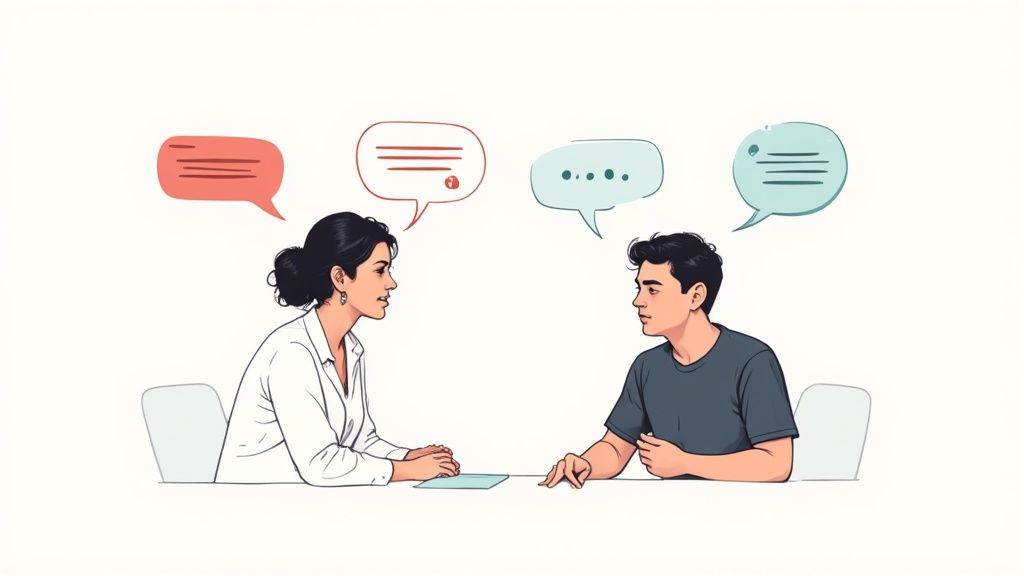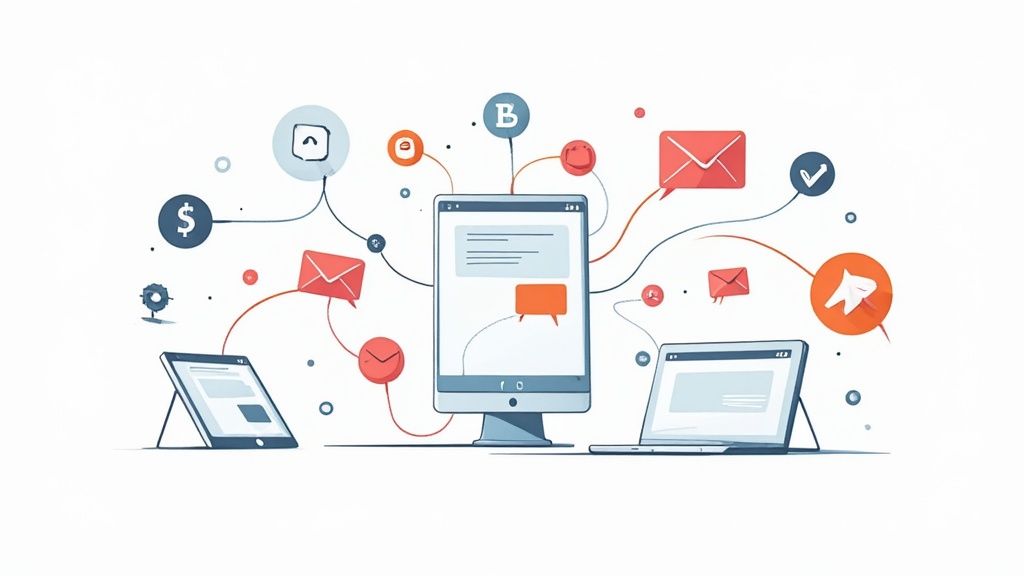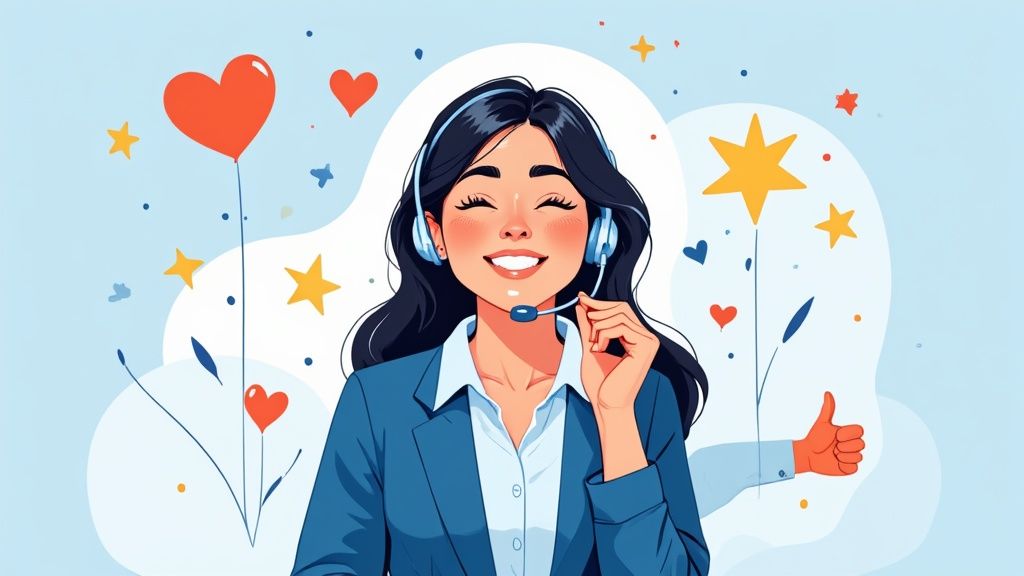The Core of Customer Service Excellence

Customer service is more than just answering questions; it's the foundation of any successful business. It encompasses every interaction a customer has with your company, shaping their overall perception and influencing their loyalty. This means that honing customer service skills is crucial for retaining current customers and attracting new ones. Just as a solid foundation supports a house, excellent customer service is the bedrock of a thriving business.
Why Customer Service Matters
Strong customer service directly impacts customer loyalty and, as a result, business growth. When customers feel valued and heard, they're more likely to come back for more. For instance, imagine a customer who has a positive experience resolving a shipping issue. If the representative is helpful and empathetic, that customer is more likely to shop with that company again. This positive feedback loop highlights the importance of investing in better customer service skills. Moreover, happy customers often become brand advocates, recommending your business to their networks, expanding your reach organically.
The Pillars of Excellent Customer Service
Exceptional customer service rests on several key principles. Clear and effective communication is paramount. This means articulating information clearly, listening attentively to customer concerns, and responding with understanding. Think of it as a well-coordinated team: each member must communicate effectively to achieve a common goal. Further enhancing communication is the ability to tailor your approach to individual customer needs. Just as a tailor adjusts clothing for a perfect fit, a skilled customer service representative adapts their communication style to resonate with each customer. This adaptability is essential for building strong customer relationships.
Building a Customer-Centric Culture
Improving customer service isn't a one-time project, but a continuous journey of learning and refinement. It requires cultivating a company culture that prioritizes the customer experience. This involves providing ongoing training, encouraging feedback and open communication, and empowering employees to own customer interactions. This is like tending a garden: consistent care and attention yield the best results. Furthermore, a customer-centric culture enables employees to find creative solutions to customer problems, solidifying the customer-business bond. By embracing these core principles, businesses can create a culture of customer service excellence and enjoy the benefits of increased loyalty, positive word-of-mouth, and ultimately, a healthy bottom line. This brings us to the essential skill of active listening.
Active Listening Techniques

Active listening goes beyond simply hearing words; it's about understanding the message behind them. It's a vital skill for any customer service representative, allowing them to connect with customers on a deeper level and offer more effective solutions. This involves concentrating on what the customer is saying, both verbally and nonverbally, and responding in a way that shows true understanding. It's similar to catching a baseball: you focus on its trajectory, anticipate its landing, and position yourself for the catch. Active listening, too, requires focus, anticipation, and positioning to grasp the full message.
Key Components of Active Listening
Several elements contribute to effective active listening in customer service. Paying attention is the first step. This means minimizing distractions and giving the customer your undivided attention. For example, setting aside other tasks and concentrating solely on the conversation helps you absorb all aspects of the customer's message. Empathy is also critical. This involves understanding and acknowledging the customer's emotions, even if you don't share their viewpoint. Try to see the situation from their perspective, as this can de-escalate tension and build rapport.
Putting Active Listening into Practice
Improving customer service through active listening means using practical techniques. One effective method is reflecting and clarifying. Paraphrase the customer's concerns to ensure you understand and ask clarifying questions to remove any ambiguities. This is like double-checking a complex instruction manual to ensure accuracy before proceeding. Nonverbal cues, such as nodding and maintaining eye contact (when appropriate), show attentiveness and encourage further sharing. However, be aware of cultural nuances, as some gestures might carry different meanings. Summarizing key points at the end confirms understanding and provides closure. By practicing these techniques, representatives can greatly improve their ability to connect with customers, address their needs, and provide outstanding service that builds loyalty and drives business growth. This naturally leads to the discussion of handling difficult situations.
Handling Difficult Situations
Strong customer service isn't just about smooth interactions; it's about navigating challenging situations with grace and skill. While stressful, these scenarios offer valuable opportunities to showcase true customer service excellence and solidify relationships. Like a captain navigating a storm, the true test of skill lies in handling turbulent situations.
Understanding the Roots of Difficult Situations
Before addressing solutions, it's crucial to understand the origins of difficult interactions. They often arise from unmet expectations. This might be frustration over a late delivery, confusion about a product, or anger over a perceived wrong. For example, a customer expecting next-day delivery might be upset by an unexplained delay. Miscommunication can further complicate matters. A poorly worded email or a rushed response can easily be misinterpreted, escalating the issue. Therefore, improving customer service requires understanding the reasons behind customer dissatisfaction.
De-escalation Techniques: Calming the Storm
When a situation heats up, de-escalation is key. Start by acknowledging the customer's emotions. Validate their feelings, even if you don't agree with their assessment. A simple "I understand your frustration" can significantly ease tension. Think of it like slowly deflating a balloon, preventing it from bursting. Active listening is vital here. By truly listening and reflecting the customer's words, you demonstrate empathy and build rapport, facilitating a more constructive conversation.
Finding Solutions: Charting a Course Forward
After calming the situation, focus on finding a solution. Clearly explain the steps you'll take and provide realistic timelines. This transparency builds trust and manages expectations. It's like offering a map to a lost traveler, guiding them towards their destination. Sometimes, a perfect solution isn't feasible. In such cases, offering alternatives empowers the customer and demonstrates your commitment. This might involve a discount or a service upgrade. These gestures, while small, can significantly improve satisfaction and build loyalty. By mastering these techniques, representatives can transform difficult interactions into opportunities to showcase their skills, strengthen relationships, and demonstrate the company's dedication to excellent service. This leads us to the crucial role of empathy in customer service.
Empathy in Customer Service

Handling difficult situations often depends on empathy. This goes beyond simply acknowledging frustration; it involves genuinely understanding and sharing the customer's feelings. Empathy is the ability to see the situation from their perspective, forging a connection that transcends a mere transaction. This connection is the cornerstone of trust and lasting customer satisfaction. Think of it like tuning a radio: you adjust the dial to the right frequency to receive the broadcast. Empathy allows you to tune into the customer's emotional frequency, understanding their message clearly.
Why is Empathy Important in Customer Interactions?
Empathy is crucial for de-escalating tense situations and building rapport. When customers feel understood, they're more open to solutions. For example, a customer grappling with a technical issue may be more concerned about the disruption to their work than the technical details. By acknowledging this underlying concern and showing understanding, a representative can ease anxiety and create a more positive problem-solving environment. This prevents escalation, leading to a better outcome for all involved. This understanding is fundamental to improving customer service and creating positive experiences.
Developing and Demonstrating Empathy
Developing empathy isn't always innate; it's a skill that can be learned and honed. One effective technique is active listening with the intent to understand, not just respond. Pay attention to the customer's words, tone, and even their silences to grasp the emotional context. Asking clarifying questions shows genuine interest and encourages elaboration. It's like peeling back layers of an onion, each question revealing another layer of the customer's experience. Expressing empathy is just as vital. Phrases like "I can see why you'd be frustrated" or "I understand this is a difficult situation" validate the customer's emotions and strengthen the connection.
The Impact of Empathy on Customer Loyalty
Empathy builds stronger customer relationships and fosters loyalty. By showing empathy, businesses demonstrate that they value customers as individuals, not just transactions. This builds trust and encourages repeat business, making it a strategic investment. It creates a positive cycle: empathetic service leads to satisfied customers who become loyal advocates. In today's competitive landscape, where customers have abundant choices, empathy is a powerful differentiator. It sets businesses apart and cultivates a loyal base. By prioritizing empathy, businesses gain a competitive edge, stronger relationships, and ultimately, sustainable growth. This understanding of empathy forms the basis for exploring effective digital communication.
Digital Communication Skills

A strong foundation in empathy sets the stage for effective digital communication, a crucial aspect of modern customer service. With interactions increasingly happening online, digital communication skills are essential for delivering outstanding service. This shift presents both opportunities and challenges. While email and chat offer convenience and speed, they lack the nuances of in-person interaction, making it harder to gauge customer sentiment. Mastering digital communication is therefore essential.
Mastering Email Communication
Email remains a cornerstone of customer service, requiring a specific skillset. Clarity and conciseness are vital. Like a sculptor chiseling away excess stone, a skilled representative crafts emails that are direct, informative, and easy to understand. A professional tone with a touch of personalization enhances the experience. Addressing the customer by name and referencing past interactions shows attentiveness. However, avoid overly casual language or emojis, which can seem unprofessional. Striking this balance is crucial for effective digital customer service.
Navigating the World of Live Chat
Live chat presents its own set of challenges and opportunities. Speed and efficiency are paramount. Customers expect quick replies, and delays can breed frustration. This means mastering multitasking while maintaining focus on each interaction. Think of a juggler keeping multiple balls in the air: each ball represents a customer, and the juggler must skillfully manage each one. Concise yet informative communication is also essential. Unlike email, live chat demands brevity, requiring representatives to convey information swiftly and effectively. Clear language and a friendly tone contribute to positive live chat experiences. Proficiency in this area is increasingly important for effective customer service.
Social Media and Customer Service
Social media platforms have become another avenue for customer service interactions. Addressing customer issues publicly requires careful consideration. Transparency and responsiveness are key. Publicly acknowledging and addressing an issue builds trust and reassures potential customers. Avoid arguments or defensiveness. This requires staying calm and professional, even when faced with negative feedback. Like a diplomat navigating complex international relations, a skilled representative handles social media interactions with grace and professionalism, turning potentially negative situations into opportunities to demonstrate commitment to customer satisfaction. This skill is increasingly important in our interconnected world. By mastering these digital communication skills, businesses can provide excellent service across all channels, build strong relationships, and foster loyalty in the digital age. This naturally leads to a discussion of continuous improvement in customer service.
Continuous Improvement
Mastering digital communication skills equips your team to handle most customer interactions. However, the journey of improving customer service is ongoing, like honing a musical instrument – consistent practice is key to mastery. This demands a commitment to continuous improvement, adapting to evolving customer expectations and staying ahead of industry trends.
Staying Ahead of the Curve
The customer service landscape is constantly changing. New technologies emerge, communication channels shift, and customer expectations adapt. Improving customer service requires a proactive approach to learning and development. It's like navigating a river: you must constantly adjust your course to avoid obstacles. Customer service professionals must continually adapt their skills to navigate the changing currents of customer expectations and new technologies. This includes staying current with best practices, attending webinars, and seeking professional development opportunities.
The Power of Feedback
Customer feedback, both positive and negative, offers invaluable insights into the effectiveness of your service efforts. It's a wealth of information that can pinpoint areas for improvement. For instance, if multiple customers express frustration with a specific checkout process, that feedback highlights a need for change. Internal feedback within the support team is also essential. Team members can learn from each other, share best practices, and identify areas for streamlining processes. This collaborative approach fosters a culture of learning and development.
Building a Culture of Learning
Improving customer service isn't solely an individual pursuit; it's a team effort. Creating a culture of continuous learning within the customer service team is vital. This means providing regular training, encouraging knowledge sharing, and celebrating successes. Like building a strong house, each brick (individual skill) contributes to the overall structure (team proficiency). Recognizing and rewarding exceptional service reinforces positive behaviors and motivates team members. By fostering this culture, businesses empower their customer service teams to deliver exceptional experiences that drive loyalty and contribute to sustainable growth. This commitment to ongoing improvement ensures that customer service remains a key differentiator in today's competitive market.
Ready to empower your customer support team and unlock the power of real-time customer feedback? SupportMan integrates seamlessly with Intercom and Slack, providing instant notifications, team discussion features, and insightful weekly reports. Start your free trial today (no credit card required) and discover how SupportMan can transform your customer service experience! https://supportman.io


